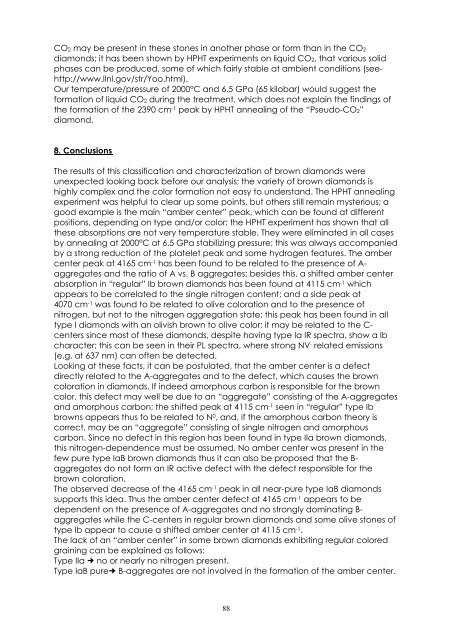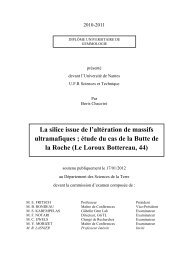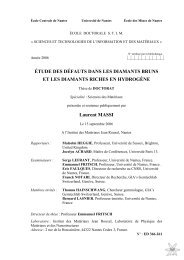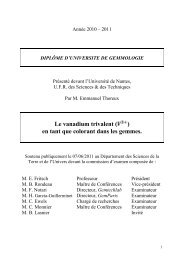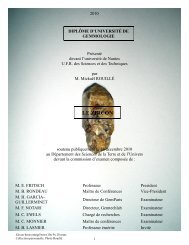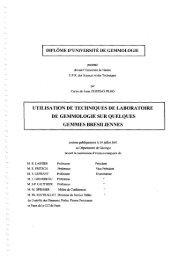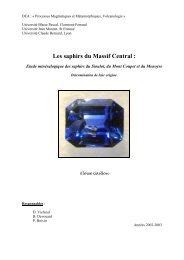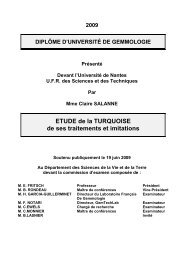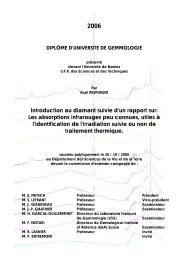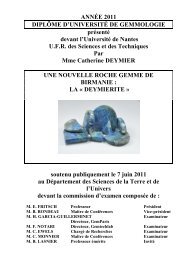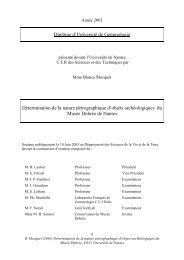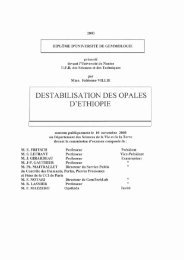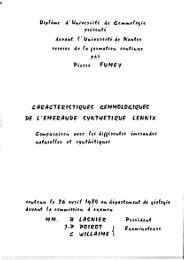Classification of brown diamonds and their color origin - GemNantes
Classification of brown diamonds and their color origin - GemNantes
Classification of brown diamonds and their color origin - GemNantes
You also want an ePaper? Increase the reach of your titles
YUMPU automatically turns print PDFs into web optimized ePapers that Google loves.
CO2 may be present in these stones in another phase or form than in the CO2<br />
<strong>diamonds</strong>; it has been shown by HPHT experiments on liquid CO2, that various solid<br />
phases can be produced, some <strong>of</strong> which fairly stable at ambient conditions (seehttp://www.llnl.gov/str/Yoo.html).<br />
Our temperature/pressure <strong>of</strong> 2000°C <strong>and</strong> 6.5 GPa (65 kilobar) would suggest the<br />
formation <strong>of</strong> liquid CO2 during the treatment, which does not explain the findings <strong>of</strong><br />
the formation <strong>of</strong> the 2390 cm -1 peak by HPHT annealing <strong>of</strong> the “Pseudo-CO2”<br />
diamond.<br />
8. Conclusions<br />
The results <strong>of</strong> this classification <strong>and</strong> characterization <strong>of</strong> <strong>brown</strong> <strong>diamonds</strong> were<br />
unexpected looking back before our analysis; the variety <strong>of</strong> <strong>brown</strong> <strong>diamonds</strong> is<br />
highly complex <strong>and</strong> the <strong>color</strong> formation not easy to underst<strong>and</strong>. The HPHT annealing<br />
experiment was helpful to clear up some points, but others still remain mysterious; a<br />
good example is the main “amber center” peak, which can be found at different<br />
positions, depending on type <strong>and</strong>/or <strong>color</strong>; the HPHT experiment has shown that all<br />
these absorptions are not very temperature stable. They were eliminated in all cases<br />
by annealing at 2000°C at 6.5 GPa stabilizing pressure; this was always accompanied<br />
by a strong reduction <strong>of</strong> the platelet peak <strong>and</strong> some hydrogen features. The amber<br />
center peak at 4165 cm -1 has been found to be related to the presence <strong>of</strong> A-<br />
aggregates <strong>and</strong> the ratio <strong>of</strong> A vs. B aggregates; besides this, a shifted amber center<br />
absorption in “regular” Ib <strong>brown</strong> <strong>diamonds</strong> has been found at 4115 cm -1 which<br />
appears to be correlated to the single nitrogen content; <strong>and</strong> a side peak at<br />
4070 cm -1 was found to be related to olive <strong>color</strong>ation <strong>and</strong> to the presence <strong>of</strong><br />
nitrogen, but not to the nitrogen aggregation state; this peak has been found in all<br />
type I <strong>diamonds</strong> with an olivish <strong>brown</strong> to olive <strong>color</strong>; it may be related to the C-<br />
centers since most <strong>of</strong> these <strong>diamonds</strong>, despite having type Ia IR spectra, show a Ib<br />
character; this can be seen in <strong>their</strong> PL spectra, where strong NV - related emissions<br />
(e.g. at 637 nm) can <strong>of</strong>ten be detected.<br />
Looking at these facts, it can be postulated, that the amber center is a defect<br />
directly related to the A-aggregates <strong>and</strong> to the defect, which causes the <strong>brown</strong><br />
<strong>color</strong>ation in <strong>diamonds</strong>. If indeed amorphous carbon is responsible for the <strong>brown</strong><br />
<strong>color</strong>, this defect may well be due to an “aggregate” consisting <strong>of</strong> the A-aggregates<br />
<strong>and</strong> amorphous carbon; the shifted peak at 4115 cm -1 seen in “regular” type Ib<br />
<strong>brown</strong>s appears thus to be related to N 0 , <strong>and</strong>, if the amorphous carbon theory is<br />
correct, may be an “aggregate” consisting <strong>of</strong> single nitrogen <strong>and</strong> amorphous<br />
carbon. Since no defect in this region has been found in type IIa <strong>brown</strong> <strong>diamonds</strong>,<br />
this nitrogen-dependence must be assumed. No amber center was present in the<br />
few pure type IaB <strong>brown</strong> <strong>diamonds</strong> thus it can also be proposed that the B-<br />
aggregates do not form an IR active defect with the defect responsible for the<br />
<strong>brown</strong> <strong>color</strong>ation.<br />
The observed decrease <strong>of</strong> the 4165 cm -1 peak in all near-pure type IaB <strong>diamonds</strong><br />
supports this idea. Thus the amber center defect at 4165 cm -1 appears to be<br />
dependent on the presence <strong>of</strong> A-aggregates <strong>and</strong> no strongly dominating B-<br />
aggregates while the C-centers in regular <strong>brown</strong> <strong>diamonds</strong> <strong>and</strong> some olive stones <strong>of</strong><br />
type Ib appear to cause a shifted amber center at 4115 cm -1 .<br />
The lack <strong>of</strong> an “amber center” in some <strong>brown</strong> <strong>diamonds</strong> exhibiting regular <strong>color</strong>ed<br />
graining can be explained as follows:<br />
Type IIa • no or nearly no nitrogen present.<br />
Type IaB pure• B-aggregates are not involved in the formation <strong>of</strong> the amber center.<br />
88


